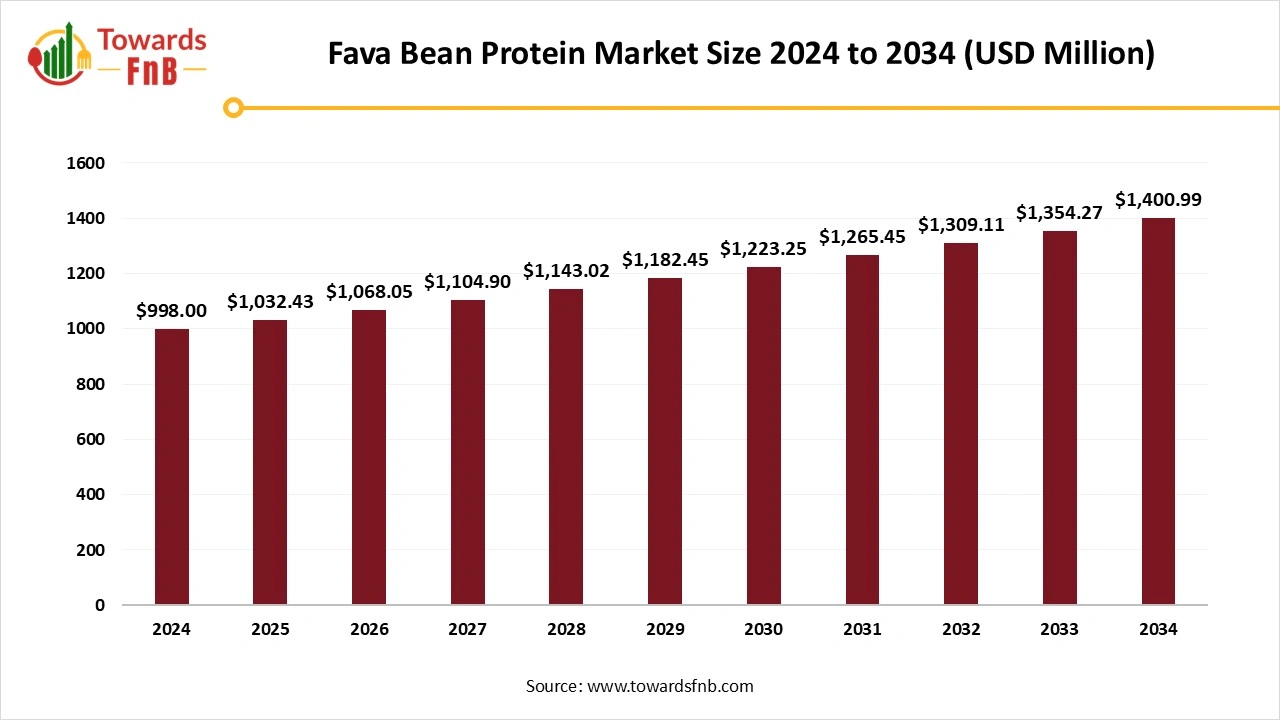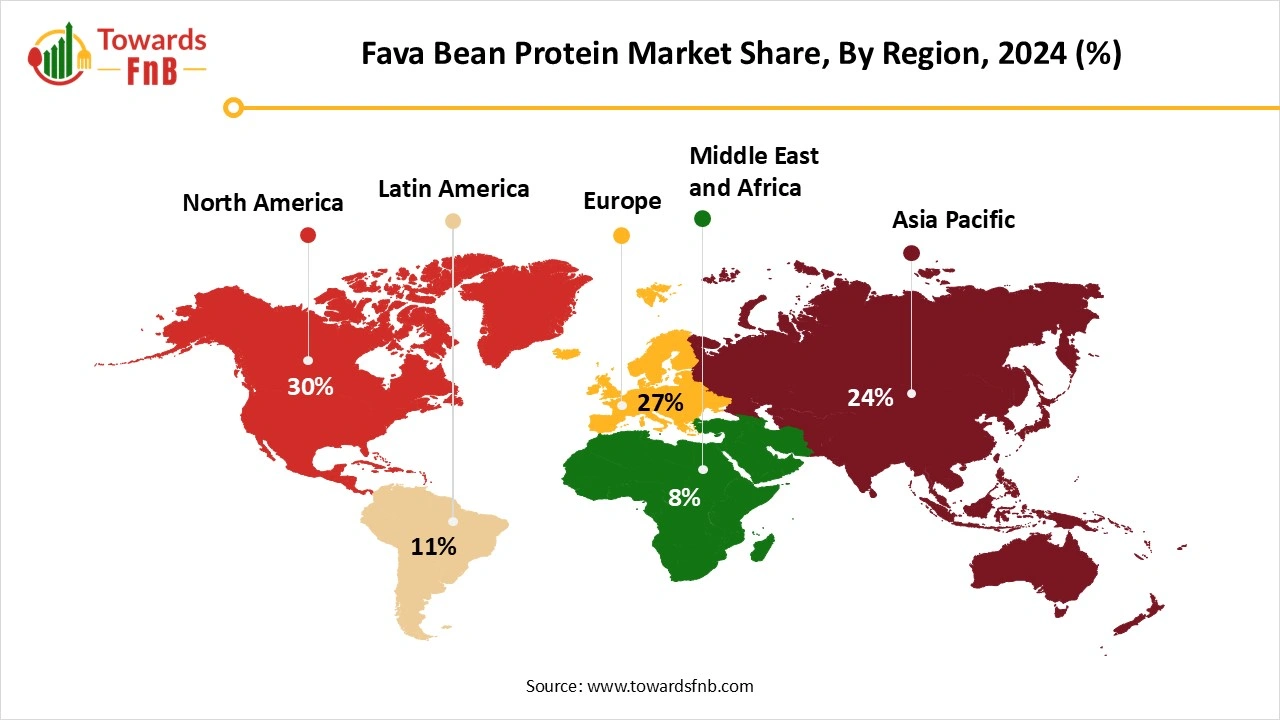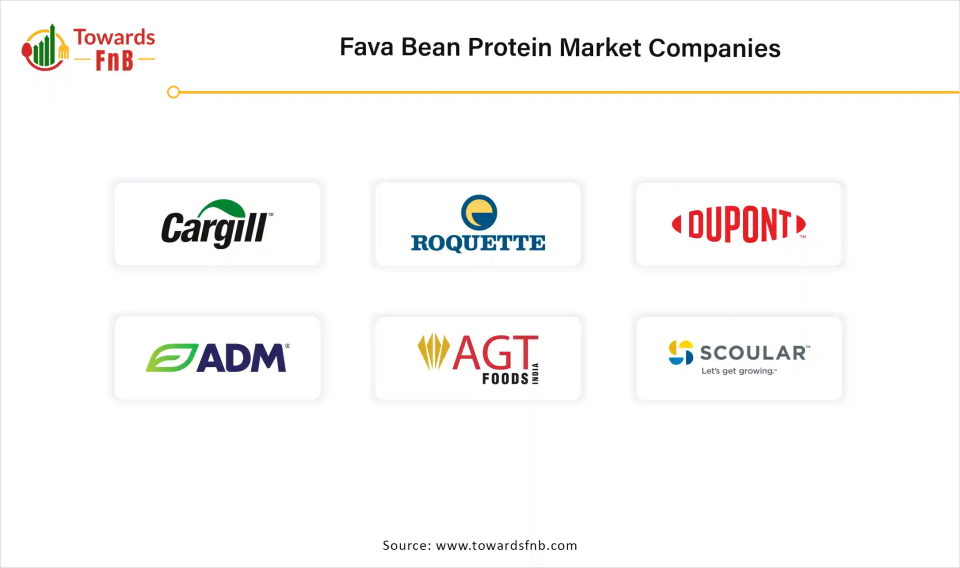January 2026
The global fava bean protein market size was valued at USD 998 million in 2024 and is predicted to grow steadily from USD 1,032.43 million in 2025 to reach nearly USD 1,400.99 million by 2034, with a CAGR of 3.45% during the forecast period from 2025 to 2034. The excellent nutritional profile, superior functionality, and good nitrogen fixation ability make the fava bean an ideal plant-based protein.

| Study Coverage | Details |
| Growth Rate from 2025 to 2034 | CAGR of 3.45% |
| Market Size in 2025 | USD 1,032.43 Million |
| Market Size in 2026 | USD 1,068.05 Million |
| Market Size by 2034 | USD 1,400.99 Million |
| Largest Market | North America |
| Base Year | 2024 |
| Forecast Period | 2025 to 2034 |
| Regions Covered | North America, Europe, Asia-Pacific, Latin America, and Middle East & Africa |
The fava bean protein market pertains to the industry focused on the extraction and utilization of protein from fava beans (Vicia faba). Fava beans are a rich source of plant-based protein and have gained popularity as a sustainable alternative to animal-based proteins. Fava bean protein is used in a variety of food, beverage, and non-food applications, including in plant-based products, dietary supplements, animal feed, and cosmetic formulations. These proteins gained popularity as broad bean proteins due to their lower carbon footprint and a wide presence in various products like animal-based meat alternatives, dairy alternatives, protein powders, etc. They reduce greenhouse gas emissions and thus are environmentally sustainable.
There are various favorable doors offered by the cultivation of these broad beans and the implementation of farming strategies. These include precision agriculture and value chain development, which improve profitability and market access. Farmers can adopt precision farming to improve resource use and increase crop yield. Moreover, plant breeding helps to ensure the expansive market reach of new crop varieties based on the specific local needs and preferences. Climate-smart agricultural practices help crops to adapt to environmental stress conditions. The nutritional value of fava beans can be enhanced through biofortification, which helps to address malnutrition concerns.
How North America Dominated the Fava Bean Protein Market in 2024?
North America dominated the fava bean protein market in 2024 owing to the initiatives taken by government organizations for American food systems. In July 2024, the U.S. Department of Agriculture (USDA) announced investments to create strong food supply chain in America. These investments will raise the capacities of meat and poultry processing to establish new and better markets for food producers and reduce food costs. The U.S. accounts for a strong production of genetically modified organisms (GMOs) like corn, sugar, soybean, beets, canola, and cotton. Many of these GMOs are used to produce ingredients like corn oil, corn starch, corn syrup, canola oil, soybean oil, and granulated sugar that are used by Americans. The U.S. also provides fresh fruits and vegetables in the form of GMO varieties, which include potatoes, apples, papayas, summer squash, and pink pineapples. Most of the GMO crops produced in the U.S. are used for animal food.

How does Canada Lead in Achieving Sustainability through Investments, Research, and Innovation?
Canada focuses on research and innovations in fava beans through investments in the sustainable development of fava bean proteins and the expansion of plant-based ingredient solutions. This new initiative in Canada is supported by the Protein Industries Canada (PIC), which aims to develop high-quality proteins and plant-based protein ingredients that will be used in various food products. For this purpose, several organizations have formed a partnership which includes Botaniline, BFY Proteins, Griffith Foods, and Faba Canada to create neutral-flavored faba protein ingredients.
These ingredients are expected to be used in consumer-packaged goods such as breadings and meat alternatives. This research project focuses on producing, improving, and processing fava beans to deliver proteins with high-quality, allergen-free solutions, and lower sodium ingredients that are suitable for the food industry. The Minister of Innovation, Science, and Industry of Canada stated that this project boosts the competitiveness of Canada in the global market. It also creates economic opportunities for Canadians in the ingredient manufacturing sector.
Asia Pacific is expected to grow at the fastest CAGR in the fava bean protein market during the forecast period due to funding support for R&D initiatives and public health awareness campaigns. The Good Food Institute (GFI), one of the leading industries in food and beverages, has set three goals for 2024, which include securing government support for alternative proteins, involving diverse people for alternative protein innovation, and empowering the entire alternative protein field. The GFI also contributes to creating a food industrial workforce and accelerates international scientific collaborations that will open new market pathways.
What is the Plant-based Industry in India?
There is a rising demand for confectioneries and vegan snacks, which is fueling the expansion of the vegan industry in India. There is a large production of animal-derived products such as eggs, meat, and dairy and a rising demand for animal meat in India. India accounts for a large manufacturing of plant-based foods, which include plant-based seafood, plant-based meat, and plant-based dairy products. The plant-based meat products encompass soy-based meat alternatives, pea protein-based products, mushroom-based products, legume-based products, and jackfruit-based products. Several new technologies like homogenization, high-pressure homogenization, extrusion technology, membrane extrusion, etc. are used for plant-based food production in India.
How Isolates Segment Dominated the Fava Bean Protein Market in 2024?
The isolates segment dominated the market in 2024 owing to the potential antidiabetic, anti-inflammatory, antihypertensive, and many other properties offered by this protein isolate. They are rich in bioactive peptides which deliver antioxidant and cholesterol-lowering effects. They support gut health by acting as prebiotics, which improve gut health and digestive system. This protein isolate help with muscle growth and maintenance, heart health, and immune health. The use of these nitrogen-fixing isolates improves soil fertility and delivers reduced environmental impact.
The concentrates segment is expected to grow at the fastest CAGR in the fava bean protein market during the forecast period, due to the allergen-free and gluten-free nature of these protein concentrates. They are rich in iron, magnesium, manganese, copper, potassium, folate, B vitamins, etc. which make them complete proteins for the human body. They aid in weight loss and regulation of blood pressure.
What Made Powder the Dominant Segment in the Fava Bean Protein Market in 2024?
The powder segment dominated the market in 2024 owing to the major role of powdered forms of fava bean proteins as the nutritional powerhouse and a cleaner plant-based choice. The powder forms of proteins exhibit health-boosting properties which help to prevent birth defects and support a healthy immune system. They are sustainable and versatile in nature by being good for soil health and culinary applications. The powder forms can be found in smoothies, shakes, salads, soups, baking, and many other recipes which offer great convenience of incorporation. They are enriched with a good source of iron which helps to fight against anemia.
The liquid segment is expected to grow at the fastest CAGR in the fava bean protein market during the forecast period, due to the excellent health benefits of fiber and protein in stabilizing blood sugar levels. The antioxidants and nutrients like vitamin B6, copper, and zinc help to strengthen the immune system.
How did the Food & Beverages Segment Dominate the Fava Bean Protein Market in 2024?
The food & beverages segment dominated the market in 2024 owing to the hypoallergenic effects of fava bean proteins, which are free from dairy, soy, nuts, and gluten. The segment is expected to grow at the fastest CAGR in the fava bean protein market during the forecast period. These protein products found in food and beverages exhibit excellent functional properties in terms of foaming, emulsification, binding, thickening, and improved digestibility. The neutral taste and light color of these protein products make them unique and popular in the global market. Fava beans are adaptable to use in crop rotation systems and by processing facilities.
How Texturizing Agent Segment Dominated the Fava Bean Protein Market in 2024?
The texturizing agent segment dominated the market in 2024 owing to the good gelling properties, enhanced texture, and hardness of fava bean proteins. They exhibit improved water-holding capacity and clean label profile. These proteins can be integrated into various food and drink products due to their neutral taste profile.
The nutritional enhancer segment is expected to grow at the fastest CAGR in the fava bean protein market during the forecast period, due to a good source of essential micronutrients, high protein content, and balanced amino acid profile. The powerful plant-based proteins in fava beans can enhance the nutritional quality of various food products.
What Made Conventional Fava Beans the Dominant Segment in the Fava Bean Protein Market in 2024?
The conventional fava beans segment dominated the market in 2024 owing to the contribution of conventional foods to sustainable agriculture. They help in building and repairing damaged tissues while supporting the growth of muscles.
The organic fava beans segment is expected to grow at the fastest CAGR in the fava bean protein market during the forecast period, due to the major role of organic broad beans in treating Parkinson’s disease and keeping a healthy heart. They help to reduce carbon footprint by causing lower environmental impact.
Roquette
Döhler

By Protein Type
By Form
By Application
By Functionality
By Source (Variety of Fava Beans)
By Region
January 2026
December 2025
December 2025
December 2025